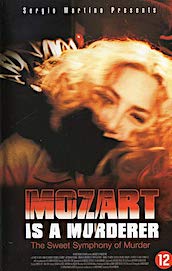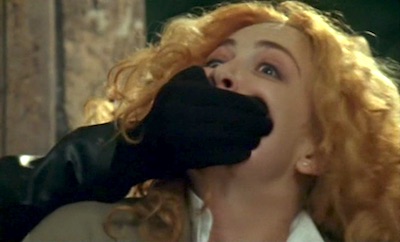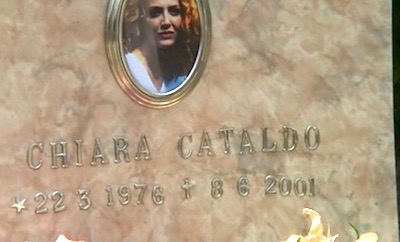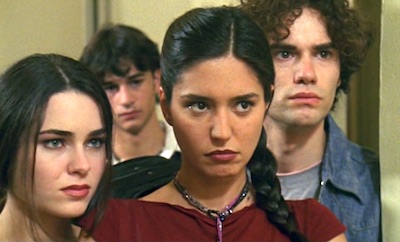(aka MOZART E UN ASSASSINO)
(1999/2002,Italy)



[review by JA Kerswell]
Sergio Martino’s giallo glory years may have been behind him at the dawn of the 21st Century, but MOZART IS A MURDERER - despite its humble TV movie origins - still proves that he remained a master of the art of Italian murder.
 |
|
| Reviews aren't usually deadly, but in MOZART IS A MURDERER they are ... |
Martino’s giallo revolves around the killings of a group of young music students at a college that begins the night after a recital of classical music ends prematurely after one of them hits a bum note. The mistake so angers their music teacher, Professor Baraldi (Alberto Di Stasio) that he threatens to suspend them all. This seemingly innocuous error kickstarts a series of deaths that may, or may not, be linked to the murders six years ago that claimed the life of the wife of Commissioner Antonio Maccari (Enzo De Caro).
Chiara (Giorgia Cardaci) is the first to fall to the knife, as she returns to her apartment that night. The killer is interrupted by an old homeless woman, who also falls prey to the killer. Their bodies are found the next morning. Maccari notes that Chiara had the symbol of the cross carved into her belly and had a bottle of drugs with a musical note on it near her body. Maccari had been trying to rebuild his life after the death of his wife at the hands of a serial killer. He is now in a relationship with therapist Dr. Marta Melli (Daniela Scarlatti), who is currently doing sessions with one of the recital group, Daniele (Stefano Scandaletti), who appears to be mixed up with drugs. Maccari tries his best to sift through the multiple red herrings and character quirks in the group to try and find the killer. However all eyes turn to Professor Baraldi after another of the group turns up dead - again with a cross carved into their stomach. Chiara’s diary reveals that she and her now deceased boyfriend were blackmailing the Professor over his predilection for young male students. Indeed, he is even seen outside the house of the second victim by two of the group Annabella (Emanuela Garuccio) and Marina (Azzurra Antonacci). However, whilst Baraldi is in custody Maccari receives a phone call, with voice heavily disguised, from someone with details of the crimes only the real killer would know. The police are back to square one, and then the murders start again …
 |
|
| Note the 2001 date on the gravestone, which perhaps suggests when the film was actually made ... |
MOZART IS A MURDERER is as wonderfully convoluted plot-wise as any classic giallo. The script by Martino himself and Francesco Contaldo twists and turns apace; shedding red herrings and possible motives like a yellow snake, before adding ever more possibilities to the plot. As is typical with the giallo, many plot elements are dead ends, but the clues to the eventual reveal and the motivation of the killer are dotted throughout. Notably a visual flourish - that flashes abstractly on the screen before the murders only to make perfect sense by the end - that was seemingly borrowed from Dario Argento’s OPERA (1987). Whilst the film is never as delirious or bonkers as earlier examples (or nearly as wonderfully demented as Lamberto Bava’s late 1980s giallo output), it is slick and gripping throughout. It also benefits from likeable turns by De Caro and Scarlatti at its centre. De Caro’s Commissioner Maccari continues the filmic tradition of giallo policemen with character quirks: his being his attachment to his cat. Whilst it certainly isn’t as stylish as Martino’s 1970s output (despite good production values it can’t escape that TV movie flatness visually). However, there are flashes of the old Martino. The scene where the killer murders someone in a giant bathtub - with the blade repeatedly slashing through the water - would fit in seamlessly with any of his classic era thrillers.
Perhaps surprisingly, given its vintage, Martino rejects the opportunity to cash in on SCREAM (1996). A film whose influence was still reverberating outside North America well into the early 2000s. It could be argued that his one concession is the young, attractive characters that make up the group of musicians who find themselves targeted. The director was, of course, no stranger to utilising teenagers or early twenty somethings (a relative oddity for main protagonists of the giallo) with his earlier TORSO (1973). Martino rejects much self-referencing, bar an amusing moment when one character bemoans how dangerous it is these days (the joke being, of course, it was much more dangerous - for fictional characters at least - in Italian film during the gialli heyday of the early 1970s). Martino otherwise plays it relatively straight. Well, as straight as any giallo can be.
 |
|
| A killer lurks at the college. Who could it be? |
Whilst Martino rejects the excesses of the genre largely, the film does benefit from the off-the-wall theory that what a baby hears in the womb could affect their personality and mental health in later life. The idea that it could even lead them to commit multiple murder doesn’t hold real world scrutiny, but is pleasingly different. MOZART IS A MURDERER is top ended by a tense closing chapter, where Maccari - to his growing horror - suspects that one of the two surviving students, who have been placed together under police protection, may be the killer.
The film’s title makes reference to the famous German composer’s death in 1791. One theory - although largely discredited today - was that he was poisoned by fellow composer Antonio Salieri. Martino implicates Mozart’s music in the genesis of the killer’s psychosis. Hence suggesting that he has a role in the killings.
MOZART IS A MURDERER wasn’t Martino’s first attemp to bring the giallo to the small screen. It follows his well received PRIVATE CRIMES (1993) four part miniseries, which reunited 1970s superstars Edwige Fenech and Ray Lovelock. Dario Argento had already utilised the medium in 1973 with his giallo anthology TV show DOOR INTO DARKNESS.
It was filmed over four weeks in and around Turin (not Rome as claimed on IMDB). Notably around the Piazza Maria Teresa in the city, with the film’s climax shot at the picturesque La Mandria Regional Park.
As big a mystery as the identity of the killer is when MOZART IS A MURDERER was actually made? It is often listed as being a 1999 release. Indeed, it is mentioned in the ‘Annuario del Cinema Italiano & Audiovisivi 1999’ journal. However, it is likely it was filmed - or at least completed - later. The Film Commission of Turin lists the film as being shot in Piedmont in 2001. That’s also the year seen on Chiara’s gravestone during the scene at her funeral. The music that the characters play was also recorded for the film in 2001. It carries a 2001 copyright and premiered on Italian television in January 2002.
Whilst not as stylish or as iconic as his classic era gialli, this is still a highly entertaining slice of Italian mayhem.
BODYCOUNT 10  female: 6 / male: 4
female: 6 / male: 4
1) Female stabbed to death
2) Female stabbed to death
3) Male stabbed to death
4) Male stabbed to death
5) Male found stabbed
6) Male found stabbed
7) Female found stabbed
8) Female found stabbed
9) Female shot in the head
10) Male shoots himself